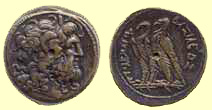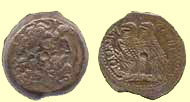
Two Eagles on Ptolemaic Coins as Representations of Co-Regency |
|||
|
|
|||
There is currently a view that different obverse and reverse types on Ptolemaic bronze coins were designed to represent various denominations. For example, the image of two eagles, such as shown above on two types of coins (click on the coins to enlarge), have been taken to indicate a double denomination. That such a view is unsustainable is reviewed in the summary of Part 2. Yet, there seems to be an unsupported conventional wisdom that two eagles represent a denomination and even that a wide variety of features on Ptolemaic bronze coins were designed to indicate denomination. The other possibility, namely that two-eagle reverse types represent co-regencies, is an idea that originated in the 19th century. Since 1897, this negative view of the two-eagle/co-regent hypothesis has been adopted by several well-known scholars and questioned only by one. However, it is now known that Strack's view was based on incorrect attributions. A further description of the background concerning the origin of this conventional wisdom is contained on pages 9-11 of the manuscript. Click Manuscript to download and read more about early views of the two-eagle hypothesis. |

